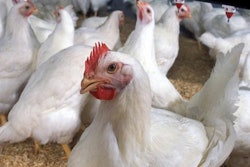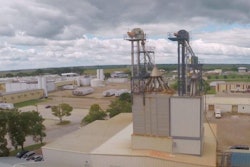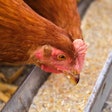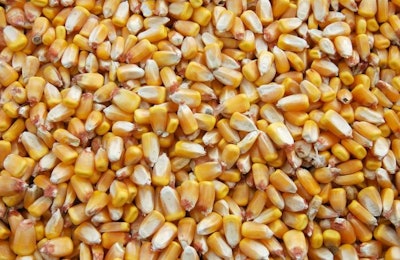
Managing feed ingredient changes in the integrated poultry complex requires teamwork among the nutritionist, the purchasing manager and the feed mill manager, said Amy Batal, Sanderson Farms, at the USPOULTRY Feed Mill Management Seminar.
Dr. Batal, the corporate veterinarian for the third-largest U.S. broiler producer, urged the feed mill managers to "speak up" with input about changes in feed ingredients with the nutritionists and purchasing managers at their poultry companies.
“The feed mill plays a huge role in managing the cost and impact of feed ingredient changes,” she said, "and feed mill managers have vital information to share about performance benefits, changes in ingredient quality and product availability.”
“The impact of ingredient changes must be evaluated all the way through the process,” Batal told the feed mill managers, “and your input about their impact is needed.”
Cost has major role in feed ingredient changes
Cost is the biggest driver of feed ingredient changes in the poultry operation, where feeding poultry flocks represents over 70 percent of total cost.
There are at least two cost-oriented scenarios behind feed ingredient changes:
- Nutrition department may dictate changes in the nutrient specifications to reduce feed formulation cost
- Purchasing department may dictate changes in feed formulation due to fluctuation in the price of alternative ingredients
Regardless of the reason, the feed mill is responsible for putting the cost-saving ideas into action, even though the feed mill manager may or may not be included in the decision.
“Your input is needed in these decisions,” Batal told the feed mill managers, because ingredient changes affect feed mill throughput, milling costs and other factors.
Purchasing department may drive feed formulation changes
Ingredient cost-saving scenarios may include the following:
- Based on the per-unit price of lysine, costs may be reduced by switching from liquid to dry lysine.
- Rising cost of phosphates may result in a switch from deflourinated phosphate to dicalcium phosphate.
Ingredient changes, such as these, must be evaluated based on feasibility. Is the necessary bin space available for additional or new ingredients? Can the new ingredients be properly weighed and included in the formulation? How will throughput in the feed mill be impacted?
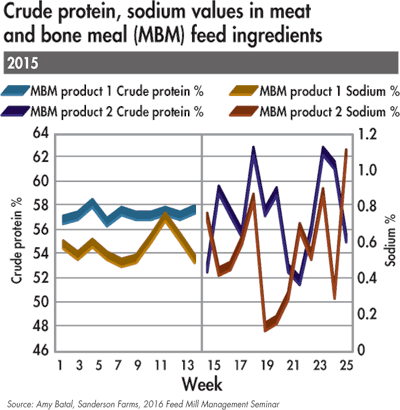
Meat and bone meal products represented in the chart have similar average crude protein and sodium values but different consistencies in those values. Product 2 – with erratic protein and sodium – is worth less as a feed ingredient.
Feed formulation changes aimed at saving on poultry feed costs may include the following:
- Rising prices of corn and fat may lead to the substitution of bakery meal in feed formulations. Will there be bin space available for the new ingredient?
- Distiller’s dried grains with solubles (DDGS) may be used as a protein and energy supplement to reduce feed costs. What is the impact on pellet quality?
“The nutritionist may expect feed formulation costs to go down $3 a ton based on an ingredient change,” Batal said, “but what if other costs in the process go up $5 a ton? How does an ingredient change affect feed manufacturing? What additional costs are incurred in receiving?"
“The feed mill manager needs to provide input about these things to the nutrition department and the ingredient purchasing department. That’s the only way we can determine the true costs and true savings involved with a new ingredient or feed formulation,” she said.
Balancing objectives in feed ingredient changes
“The ultimate goal of the integrated poultry operation is to balance feed ingredient costs, product quality and production efficiency,” Batal said.
Decisions on feed ingredient changes, she said, should factor in non-cost parameters such as the impact on the live production performance of the poultry, possible changes in feed quality and whether or not a cheaper feed ingredient is dependably available in sufficient quantity over time.
Visual inspections of feed ingredients necessary
Soybean meal, corn and DDGS purchases are based on numerical quality standards, including percentage of crude protein, moisture and other quality measures. However, feed mill managers should perform visual inspection of feed ingredients before unloading and sampling.
High-quality soybean meal (and DDGS) should have a light coloration, but a darker coloration is an indication of overcooking, which reduces the nutritional value by decreasing amino acid digestibility.
Corn should be visually inspected for broken grains, which expose the inner starch and make the ingredient susceptible to mold formation. Kernels damaged by mold or heat may be nutritionally impaired.
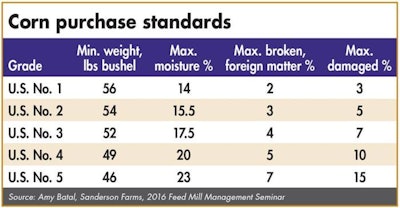
It is fairly common for feed mills to reject shipments of corn based on moisture content, but other quality attributes such as broken grains and foreign matter should be closely checked.
Be prepared to reject shipments of feed ingredients
Feed mill managers should be prepared to reject shipments of soybean meal, DDGS or corn based on visual inspection before unloading, Batal said. In fact, feed mills should not allow suppliers to presume low-quality shipments will be accepted.
Feed mills that never reject shipments of soybean meal, DDGS or corn may be at greater risk of receiving lower-quality ingredients in the future, she said.
“What is the problem with never rejecting shipments of feed ingredients? When the feed mill down the road rejects a shipment of low-quality ingredients, there should be no reason for them to presume your feed mill would accept them.”
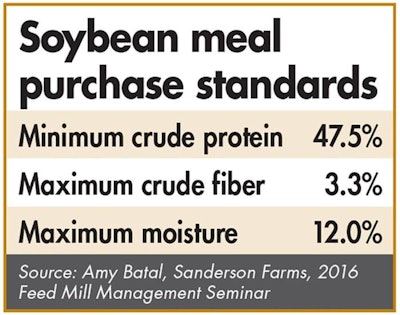
Soybean meal is purchased based on quantifiable standards, but one very important quality check should occur before unloading the product: check the color for evidence of overcooking.
Speak up about changes in feed ingredient quality
Feed mill managers need to alert the nutrition or ingredient purchasing departments when changes in ingredient quality, handling characteristics or plant of origin are detected, Batal said.
“Are you seeing changes in feed ingredient quality? Is one ingredient more variable in quality than others? Are more quality issues being experienced in ingredients received from a particular supplier?
“If product quality cannot be brought in line with requirements, it may be necessary to change suppliers or types of ingredients used in certain feed formulations,” she said.
Teamwork required in feed ingredient changes
The ultimate goal in managing feed ingredient changes in the integrated poultry complex is to achieve balance in ingredient cost, product quality and production efficiency, Batal concluded. This can only be achieved with teamwork among the nutritionist, ingredient purchasing manager and feed mill manager.



